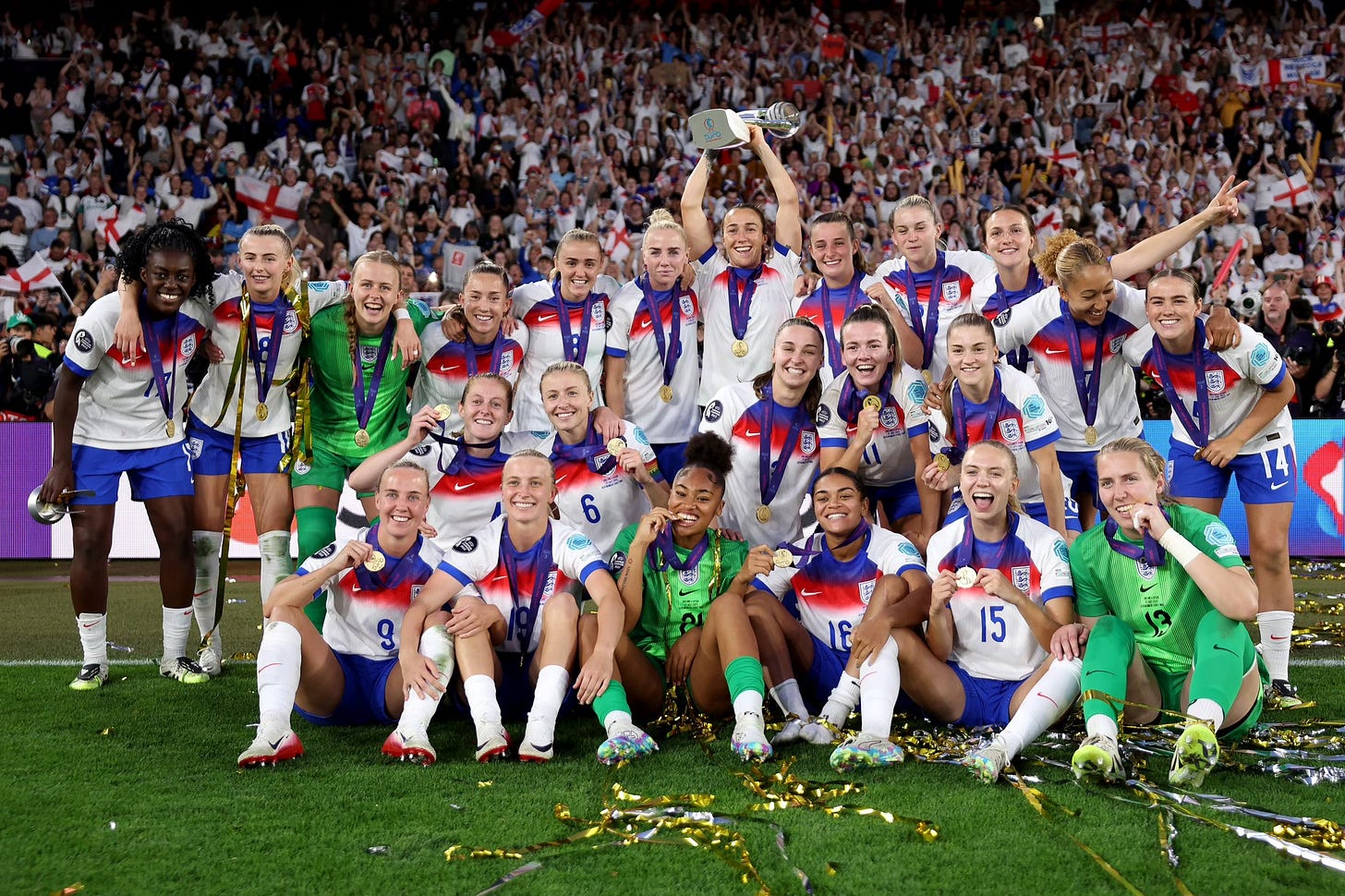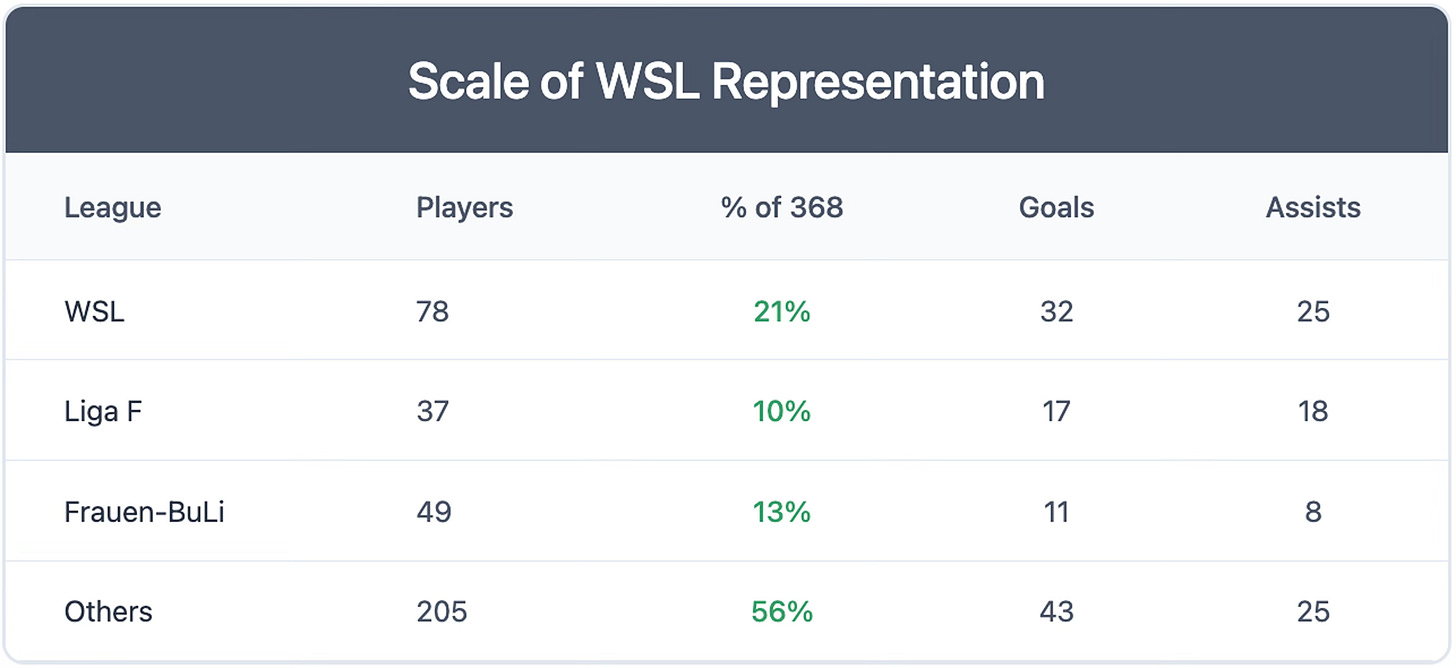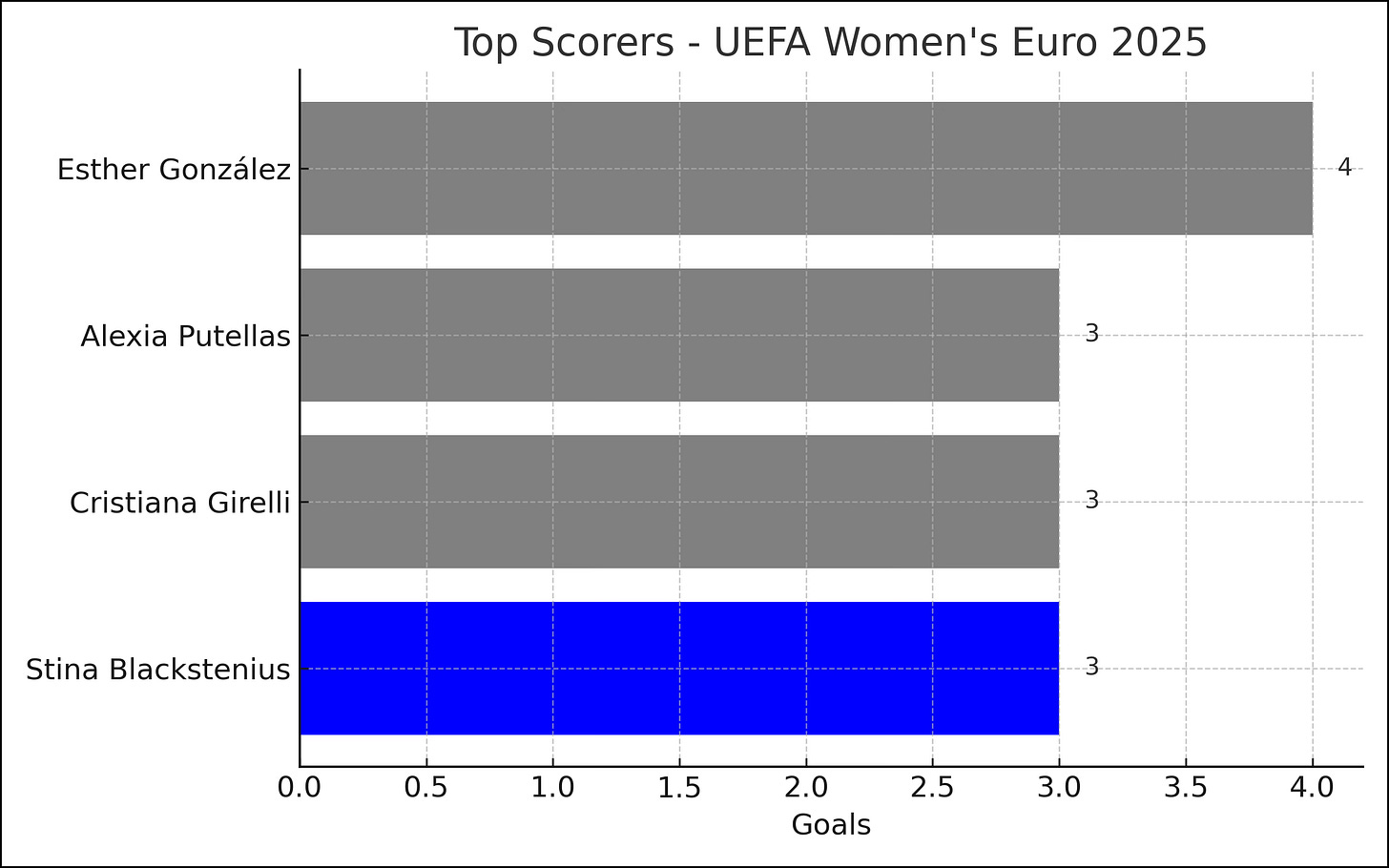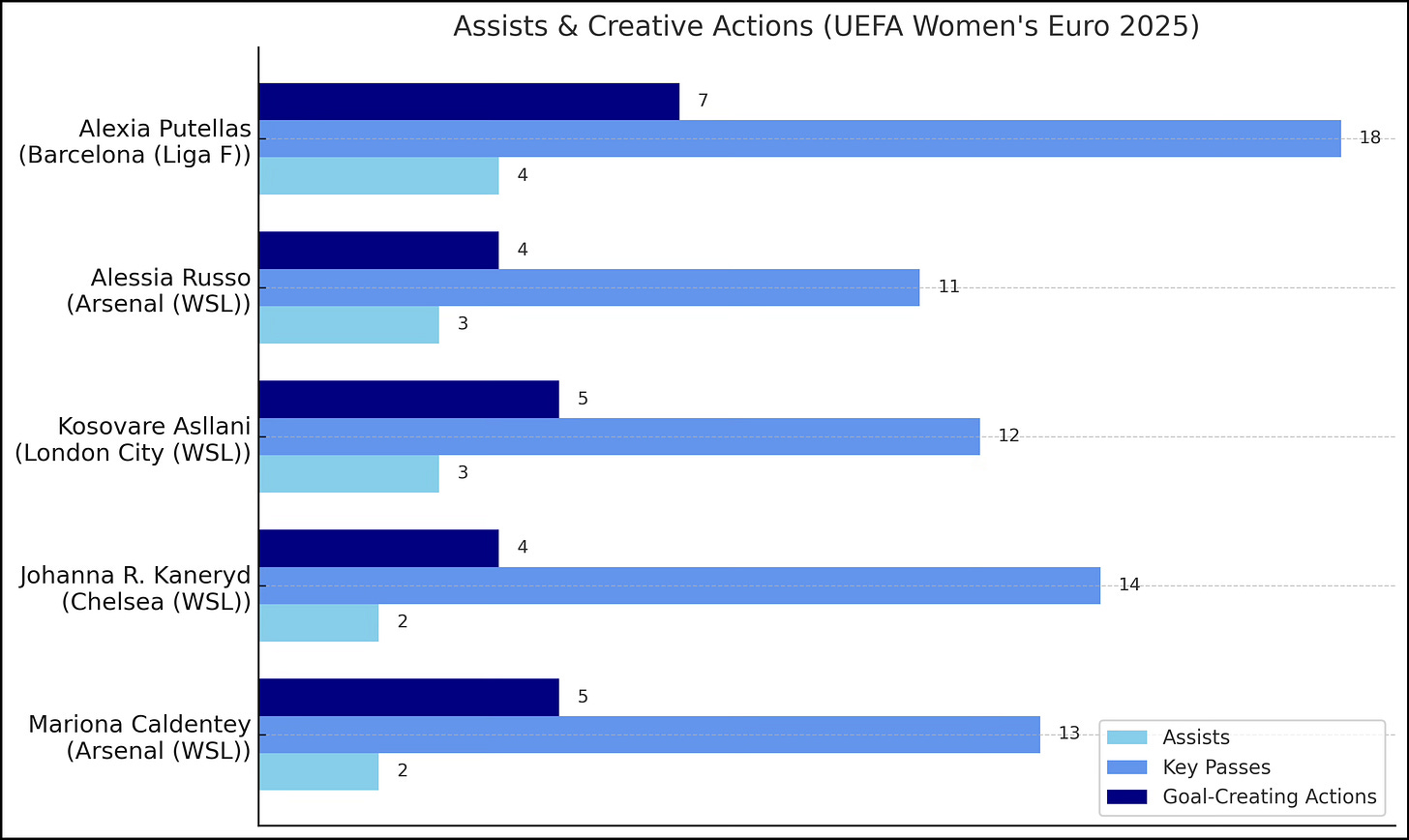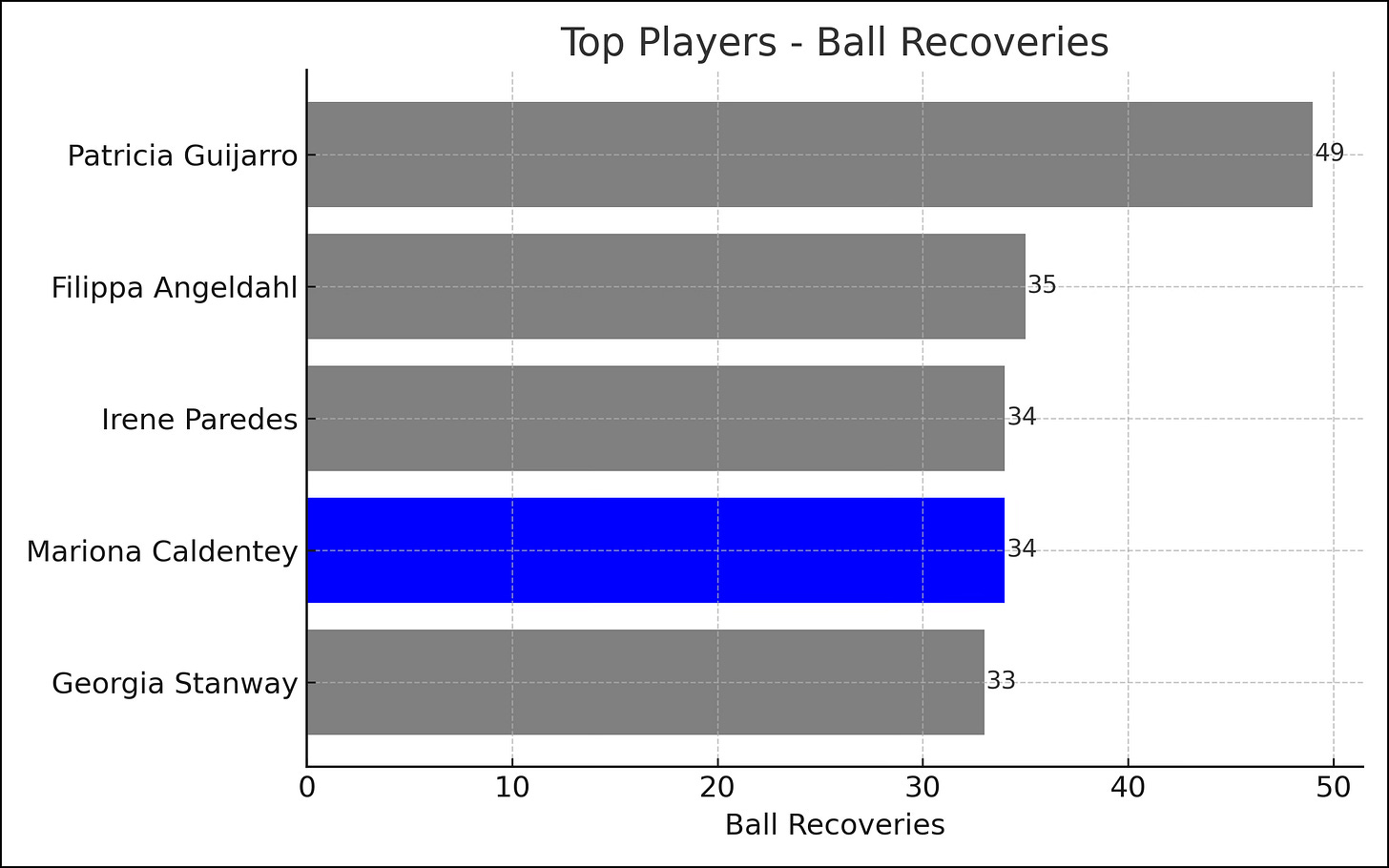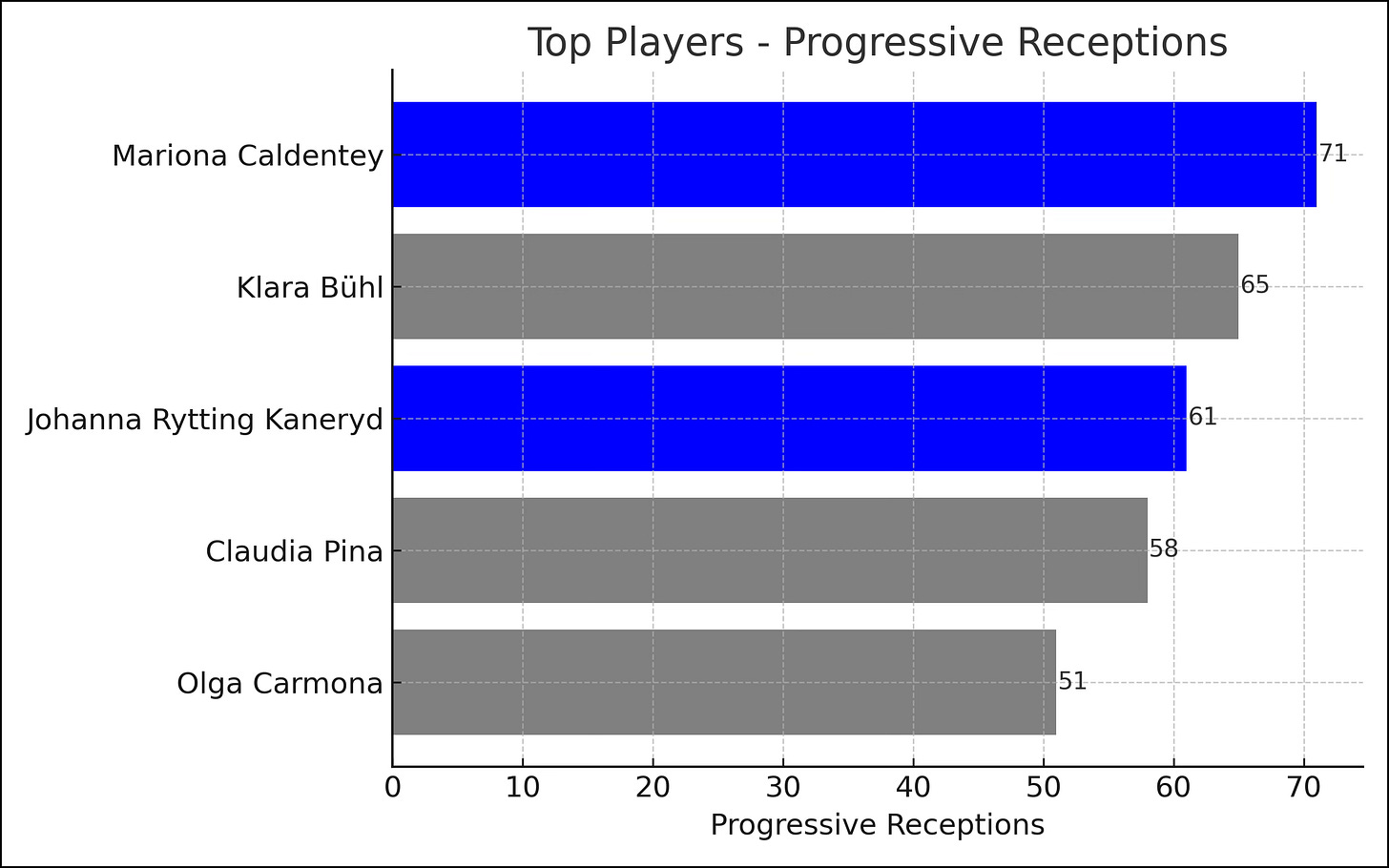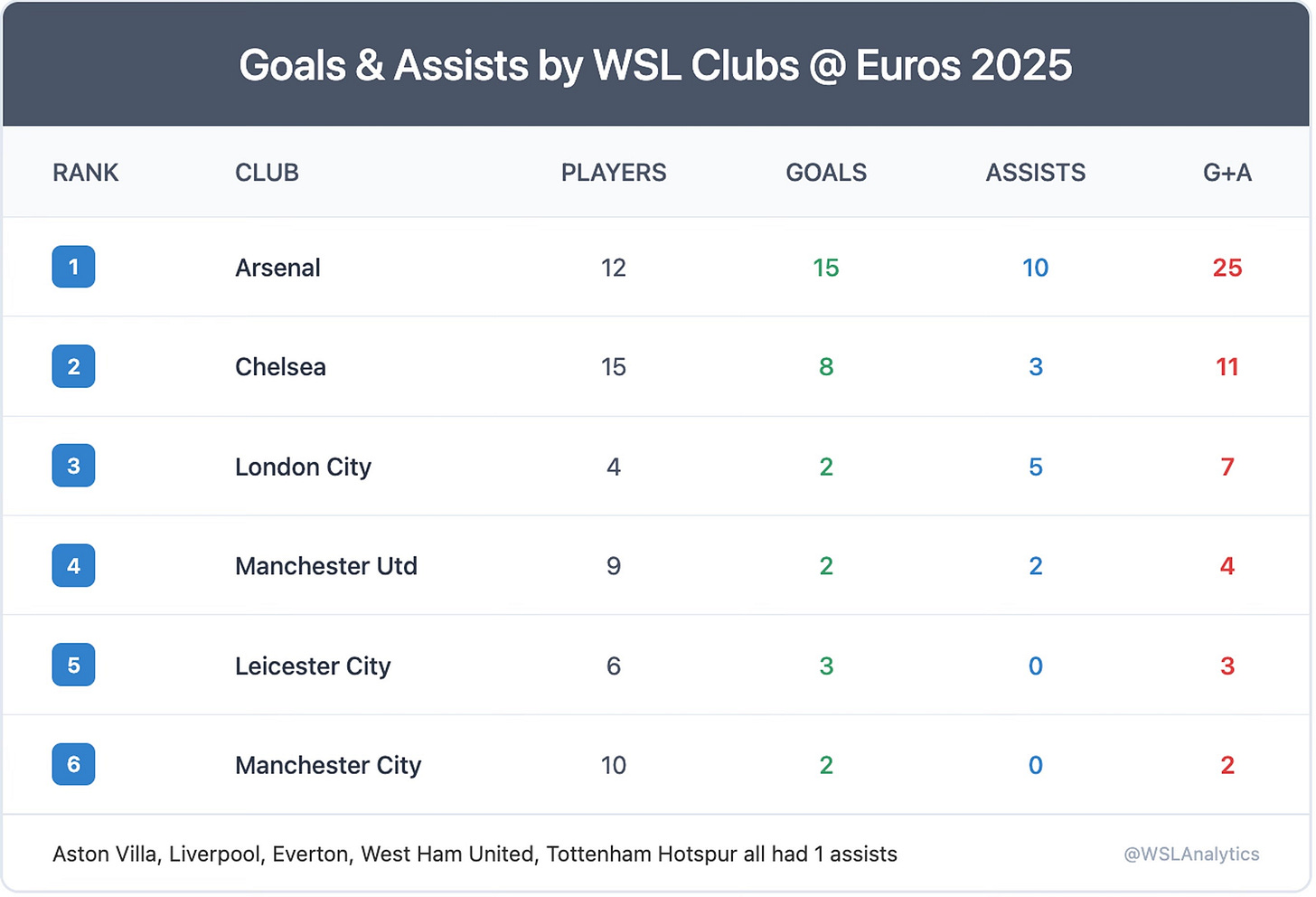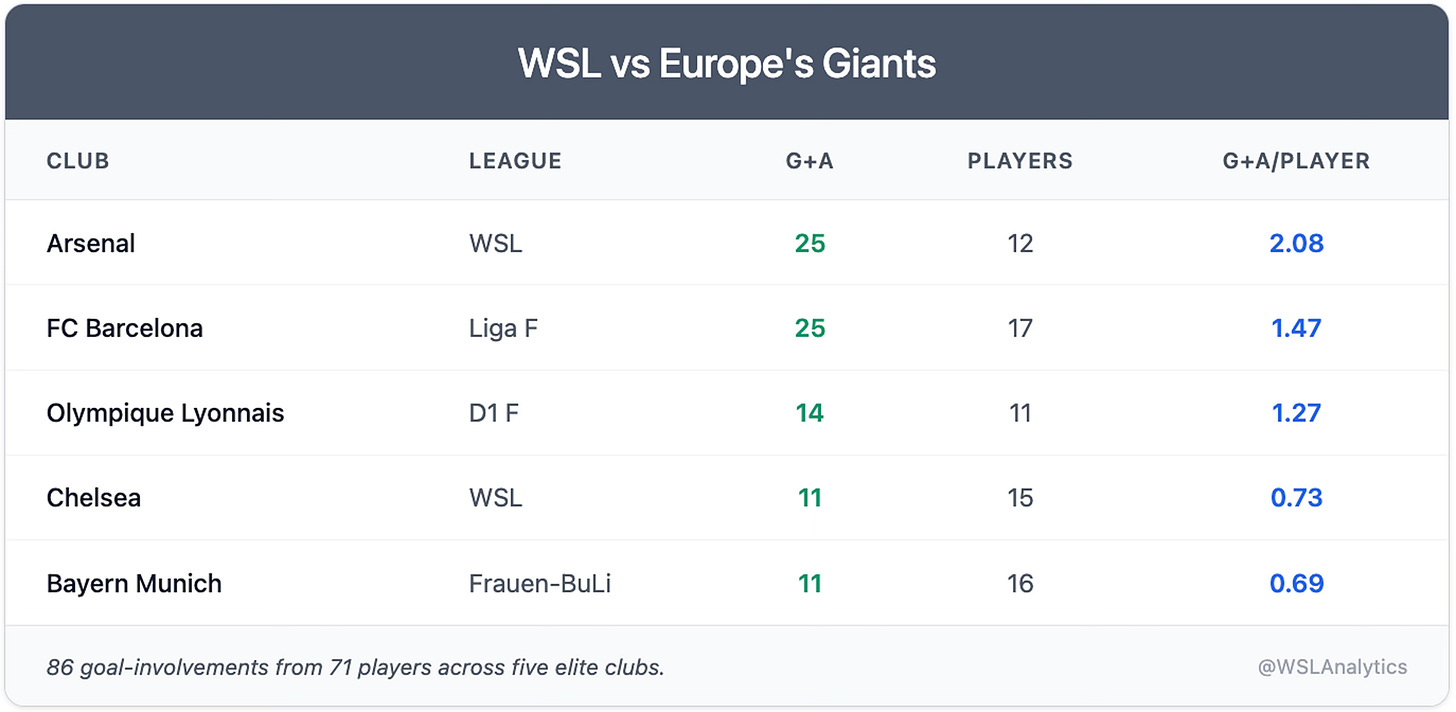Punching Above Their Weight: How WSL Stars Dominated Euro 2025
How England's top flight delivered 31% of goals with just 21% of players
Executive Summary
WSL players punched above their weight – though only 78 players (21% of the tournament) represented England’s top flight, they delivered 32 of 103 goals (31%) and 25 of 76 assists (33%).
Arsenal’s 12‑player contingent matched FC Barcelona for the most combined goals & assists by any club (25 G+A).
Chelsea’s internationals led all clubs in defensive output with 117 tackles + interceptions and 214 ball recoveries, while their two goalkeepers produced 2 clean sheets, the most of any club.
London City Lionesses, newly promoted, ranked third among WSL clubs for goal involvements thanks to Kosovare Asllani and Daniëlle van de Donk’s playmaking (7 G+A from just 4 players).
Standout individuals included Stina Blackstenius (3 G), Alessia Russo (5 G+A), Mariona Caldentey (tournament‑leading 21 passes into the box, 71 progressive receptions), and Keira Walsh/Lia Wälti (22 tackles + interceptions each).
1. WSL Representation
WSL share of attacking output outstripped its share of player pool.
2. Player‑Level Performance
2.1 Attacking Output
Golden Boot chase
The tournament’s Golden Boot was won by Spain’s Esther González (NWSL) with 4 Goals. Just behind her, Stina Blackstenius (Arsenal, WSL) was part of a three-way tie on 3 Goals.
Blackstenius’s 3 goals made her the top-scoring WSL player, alongside non-WSL stars Alexia Putellas (Barcelona) and Cristiana Girelli (Juventus) who also netted 3 each.
Notably, WSL players collectively scored nearly one-third of all goals, underlining the league’s attacking quality.
Top goal scorers at Euro 2025. WSL player Stina Blackstenius (in blue) was among the joint-second highest scorers with 3 goals
Shooting and Efficiency
WSL attackers were active in front of goal. Blackstenius led WSL players with 21 shots (7 on target), translating her chances into 3 goals.
By contrast, Germany’s Klara Bühl (Frauen-Bundesliga) had a tournament-high 24 shots without scoring, highlighting Blackstenius’s superior finishing.
Spain’s Esther González managed 4 goals from 23 shots – a solid conversion that edged Blackstenius for the Golden Boot.
WSL’s attacking efficiency was further evident as WSL players scored ~31% of goals from ~26% of total shots, indicating above-average conversion rates.
Assists and Chance Creation
Playmaking was another area of WSL impact. Spain’s Alexia Putellas topped the assist chart with 4 assists, but close behind were Alessia Russo (Arsenal, WSL) and Kosovare Asllani (London City, WSL) with 3 assists each.
Asllani’s playmaking helped her tally 5 goal contributions (2 goals, 3 assists) – matching Russo and second only to Alexia’s 7.
In creative build-up metrics, WSL players excelled as well. Goal-Creating Actions (GCAs) measure the two actions leading to a goal (passes, shots, dribbles, etc.), and Russo registered 4 GCAs, just one behind tournament-leader Alexia (5 GCAs).
WSL wingers provided plenty of service: Johanna Rytting Kaneryd (Chelsea, WSL) led all players with 14 key passes (passes leading to a shot), reflecting her role in Sweden’s attack. This edged out Alexia’s 13 key passes and underscores how a WSL player topped a crucial chance-creation metric.
Shot-Creating Actions
Beyond assists, Shot-Creating Actions (SCAs) count contributions to shot opportunities. Barcelona’s midfielders dominated here (Alexia had 35 SCAs), but WSL’s Mariona Caldentey (Arsenal) was not far behind with 30 SCAs – the highest of any WSL player and 4th overall.
Kaneryd and Russo also shined, recording 22 and 20 SCAs respectively, reflecting how WSL attackers were heavily involved in build-up play.
In summary, WSL players were key protagonists in attack – scoring and assisting a large share of goals and frequently featuring in the build-up to chances.
Alexia Putellas led the way with 4 assists and a tournament-high 7 goal-creating actions, while Alessia Russo (3 assists, 4 GCAs) and Mariona Caldentey (2 assists, 5 GCAs) ensured strong WSL representation in the creative charts. Notably, Johanna Kaneryd recorded 14 key passes—the most of any player—despite fewer direct assists.
2.2 Passing Performance
In the passing department, WSL players displayed both creative vision and progressive distribution, often rivaling the best from other leagues:
Progressive Passing
Progressive passes are those that move the ball significantly forward.
Spain's Patricia Guijarro (Barcelona) led all players with a remarkable 69 progressive passes, but the WSL's best was not far behind – Mariona Caldentey logged 52 progressive passes, the second-most of the tournament.
England's defenders in WSL were also influential in build-up: Alex Greenwood (Man City) made 45 progressive passes, and Lucy Bronze (Chelsea) had 40.
These high numbers indicate WSL players shouldered major playmaking responsibilities for their teams, moving the ball upfield effectively.
Passing into the Final Third
WSL creativity is further highlighted by passes into dangerous areas.
Mariona Caldentey delivered 21 passes into the penalty area, the most of any player at Euro 2025. This even surpassed Alexia's 18 and far outstripped other playmakers. Caldentey's ability to feed strikers exemplified WSL players' incisiveness in the final third.
Other WSL contributors included Lauren Hemp (Man City) with 11 passes into the box and Chloe Kelly (Arsenal) with 5. WSL midfielders also played key passes through defenses; for example, Danielle van de Donk (London City, WSL) had 2 assists from midfield and several key through-balls.
Passing Accuracy
In terms of ball retention, WSL players showed composure. England captain Leah Williamson (Arsenal) completed 86.0% of her passes, one of the highest accuracy rates among high-volume passers (just shy of Guijarro's 86.6% for Spain).
Several other WSL players (e.g. Greenwood ~80%, Caldentey ~80.6%) maintained strong passing percentages despite attempting many progressive balls. This suggests that WSL players combined aggression with accuracy in distribution.
Overall, the passing data reveals that WSL players were pivotal in transitioning play forward and creating chances, often matching or exceeding the output of their peers from Spain's Liga F or France's Division 1 in key passing metrics.
2.3 Defensive Performance
WSL players also made their mark defensively, contributing heavily to tackles, interceptions, and other defensive actions throughout the tournament:
Tackles and Interceptions
Germany's Elisa Senß led the tournament with 26 combined tackles + interceptions, but WSL standouts were close behind.
Keira Walsh (Chelsea) and Lia Wälti (Arsenal) each tallied 22 tackles+interceptions, tying WSL colleague Sjoeke Nüsken (Chelsea) at that mark. Nüsken's total (22) was fifth overall in the tournament, illustrating WSL representation among the elite ball-winners.
Notably, Walsh and Wälti operated as midfield anchors for England and Switzerland respectively, and their high defensive action counts underscore their important ball-winning roles for their national teams.
Ball Recoveries
Aggressive defensive work by WSL players is further seen in ball recoveries (regaining loose balls or interceptions). Spain's Guijarro dominated with 49 recoveries, but Mariona Caldentey – typically an attacking wide player for Spain – showcased tremendous work rate with 34 recoveries, the most among WSL players.
Caldentey's number was tied for third overall, reflecting how she and other WSL players contributed in pressuring opponents and regaining possession.
England's Lucy Bronze had 33 recoveries from right-back, equal to Germany's Georgia Stanway's 33, both just outside the top three. This indicates WSL players were among the tournament's most active in regaining possession.
Top 5 players in ball recoveries. WSL players like Mariona Caldentey (34 recoveries, highlighted) ranked among the leaders, though Spain’s Patricia Guijarro led with 49.
Interceptions & Tackles
In pure interception counts, Alex Greenwood (Man City, WSL) stood out with 13 interceptions – among the top figures (no other player had more, Reuteler of Switzerland with 13 as well). Greenwood, a defender, also added 5 tackles, showing a balance of positioning and tackling.
Lia Wälti led all WSL players with 10 tackles won, illustrating her tenacity in midfield. Wälti's combined 22 tackles+interceptions were on par with the tournament's best, as mentioned.
Additionally, Sari Kees (Leicester City, WSL) made 13 blocks, the highest block total of any player, reflecting her bravery in defense for Belgium. Whether intercepting passes or throwing their bodies in front of shots, WSL players were crucial defensive pillars for their teams.
Aerial Duels
In the air, WSL players also showed dominance. Iceland's Dagný Brynjarsdóttir (West Ham, WSL) won 90% of her aerial duels – an exceptional success rate (9 out of 10 aerials won). This was one of the best aerial records in the tournament.
Sjoeke Nüsken also impressed, winning 83.3% of aerial duels as a defensive midfielder shielding Germany's back line.
These stats highlight that WSL players not only contributed on the ground but also excelled in aerial battles, often outperforming players from other leagues in aerial win percentage.
Overall, the defensive metrics illustrate a comprehensive impact: WSL players featured prominently among the top tacklers, interceptors, ball-winners, and aerial duelists of Euro 2025.
2.4 Possession & Ball Progression
"Possession" metrics – including carrying the ball forward and receiving passes in advanced areas – reveal how WSL players influenced the flow of the game when their teams had the ball:
Progressive Carries
Progressive carries measure how often players dribbled or carried the ball forward a significant distance.
The tournament's leading ball-carrier was Germany's Klara Bühl with 47 progressive carries, but among WSL players the most prolific was Lauren Hemp (Man City) with 22 progressive carries.
Hemp, an explosive winger, consistently drove at defenses for England. She was closely followed by Johanna Rytting Kaneryd (Chelsea) and Mariona Caldentey (Arsenal), each with 18 carries progressing the ball upfield.
While non-WSL stars like Bühl carried the ball more often, WSL players provided plenty of forward thrust for their sides, often leading their teams in this metric.
Progressive Receptions
This metric counts how often players receive the ball in advanced areas, behind the opposition midfield.
Mariona Caldentey led the entire tournament with 71 progressive receptions – meaning she frequently got on the end of forward passes in dangerous positions. This speaks to her intelligent movement and her teammates' trust in her positioning.
Johanna Rytting Kaneryd was third overall with 61 receptions in advanced areas, showing how Sweden's attack funneled through the Chelsea winger.
These two WSL players topped the charts above even star Spanish forwards (e.g. Claudia Pina had 58). It highlights that WSL attackers were often the ones finding space and receiving the ball in the final third.
Top 5 players by progressive receptions (times receiving forward passes). WSL players Mariona Caldentey and J. R. Kaneryd are #1 and #3, showing their off-ball movement and involvement in attacks.
3. Club‑Level Impact
3.1 Goals & Assists
Arsenal’s numbers eclipse the field, while London City over‑performs relative to squad size.
3.2 Minutes & Expected Goals
Chelsea’s 15 internationals logged 4,936 minutes – the heaviest workload – ahead of Arsenal’s 3,795 and Man City’s 2,608.
Arsenal translated volume into efficiency: 13.8 xG / 7.4 xA turned into 15 G & 10 A; Chelsea under‑converted (8 G from 8.0 xG).
3.3 Defensive & Goalkeeping Records
Chelsea: tournament‑leading 117 T+I, 214 recoveries & 2 clean sheets from Hampton and Peng.
Arsenal produced the most blocks (51) and matched Chelsea in aerial duel win‑rate (~50%).
3.4 WSL vs Europe’s Giants
Arsenal’s contingent matched Barcelona for total goal involvements despite fielding five fewer players.
4. Tactical & Strategic Trends
WSL pressing DNA travelled well. High defensive actions from Chelsea‑based players fueled pressing systems for England, Germany & Sweden.
Verticality through WSL midfielders. Caldentey & co dominated vertical progression metrics, underscoring league’s emphasis on forward tempo.
Finishing efficiency as differentiator. Arsenal & London City out‑performed xG; Manchester City under‑performed, mirroring club‑season trends.
Wider talent distribution. Mid‑table clubs like Leicester and West Ham supplied specialist contributors (blocks, saves), evidencing league depth.
5. Implications for 2025‑26 WSL Season
Arsenal’s Euro‑tested core positions them as early title favourites; Chelsea must convert defensive solidity into attacking output.
London City’s Moneyball approach validated – elite contributions from lean squad suggest upward trajectory.
Workload watch for Chelsea internationals; early season rotation crucial after 4,900‑minute summer.
Methodology & Data Sources
Primary Data Sources:
Official UEFA Women's Euro 2025 event feed for validated match outcomes, goals, assists, and squad registrations
FBref Match Logs for granular player statistics including shots, passes, defensive actions, and minutes played.
Data Processing: All raw events were normalised through the WSLAnalytics Match-Event Model to ensure consistency across metrics. Player-to-club mapping reflects each player’s registered club as of July 26, 2025.
If you found this breakdown valuable, subscribe and share – and join the conversation on X (@WSLAnalytics).


